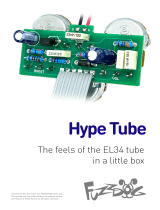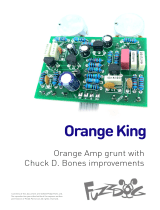Page is loading ...

Cloven Ripper
Insane fuzz action with
screaming octave-up
Contents of this document are ©2020 Pedal Parts Ltd.
No reproduction permitted without the express written
permission of Pedal Parts Ltd. All rights reserved.

Important notes
If you’re using any of our footswitch daughterboards,
DOWNLOAD THE DAUGHTERBOARD DOCUMENT
•Download and read the appropriate build document for the daughterboard
as well as this one BEFORE you start.
•DO NOT solder the supplied Current Limiting Resistor (CLR) to the main
circuit board even if there is a place for it. This should be soldered to the
footswitch daughterboard.
POWER SUPPLY
Unless otherwise stated in this document this circuit is designed to be
powered with 9V DC.
COMPONENT SPECS
Unless otherwise stated in this document:
•Resistors should be 0.25W. You can use those with higher ratings but
check the physical size of them.
•Electrolytics caps should be at least 25V for 9V circuits, 35V for 18V
circuits. Again, check physical size if using higher ratings.
LAYOUT CONVENTIONS
Unless otherwise stated in this document, the following are used:
•Electrolytic capacitors:
Long leg (anode) to square pad.
•Diodes/LEDs:
Striped leg (cathode) to square pad. Short leg to square pad for LEDs.
HOWEVER - SEE THE NOTES ON PAGE 4.
•ICs:
Square pad indicates pin 1.

Schematic + BOM
Bigger, legible versions
on following pages.
R1 39K
R2 100K
R3 470K
R4 100R
R5 15K
R6 1M
R7 2K2
R8 8K2
R9 100K
R10 470K
R11 15K
R12 100R
R13 8K2
R14 100R
R15 470K
R16 100K
R17 15K
R18 2K2
R19 39K
R20 47K
R21 100K
R22 390K
R23 2K2
R24 10K
R25 1M
R26 470K
R27 10K
R28 330R
R29 1K
R30 10K
R31 10K
R32 10K
R33 1K
R34 33K
R35 1M
R36 1K
R37 1M
R38 10K
R39 470K
R40 47K
R41 10K
R42 2K2
R43 22K
R44 10K
R45 100K
R46 100K
R47 47K
R48 47K
R49 10K
C1 100n
C2 470p
C3 100n
C4 100n
C5 470p
C6 100n
C7 100n
C8 470p
C9 100n
C10 6n8
C11 6n8
C12 100n
C13 100n
C14 100p
C15 1u elec
C16 47p
C17 100u elec
C18 10u elec
C19 470p
C20 10n
C21 1u elec
C22 1u elec
C23 22u elec
C24 1u elec
C25 100p
C26 100n
C27 100n
C28 100n
C29 100n
C30 1u elec
C31 1u elec
C32 100n
Q1 2N3904
Q2-3 2N1308 / CV7351(i)
Q4 2N3904
Q5 AC176(ii)
Q6 MPSA18
Q7 PF5102 / 2N5457(iii)
Q8 2N5089
Q9 2N5087
Q10 2N5089
D1-4 5mm Red LED
D5 1N4148
D6-7 Ge / 1N4148(iv)
D8 1N4001
HF-FUZZ 50KB
HF-TONE 100KB
HF-VOL 1MA
HF-SHIFT 25KB
RP-FUZZ 250KB
RP-TONE 100KB
RP-VOL 100KA
OCTAVE 50KB
See notes on next page.

Notes to the BOM
(i) CV7351 is the military equivalent of 2N1380. You could try other NPN
germaniums in their place. You’re looking for hFE between 150-200.
(ii) Again, other NPN germaniums could be used and it’s unikely you’ll hear a
difference. Target gain range - 70-100hFE.
(iii) We’ve added a buffered input stage to the Octave section of the circuit so you
can add an octave blend control. You can omit this section if you want to have
the octave simply switched on or off with the footswitch with no control.
To omit the buffer and octabe blend control leave out the parts marked
green in the BOM and add jumpers as shown below.
(iv) We made an error laying out the PCB, and the parts for D6-7 were the
wrong way around in the schematic (fixed on the schematic in this doc
though). As such, ‘normal’ diodes such as 1N4148 should be reversed,
i.e. striped end (cathode) to round pad. The Russian D9K we provide have the
anode indicated by the double stripes, so these should be placed with the
striped leg to the square pad. You can use silicon 1N4148 and get good results
without matching. Germaniums need to be tested and matched closely for
forward voltage to ensure a good octave-up effect. None of the other diodes on
the PCB are affected, just D6-7.


Schematic - Octave Up Section

Schematic - Ripper Section

Schematic - Cloven Muff Section

The power and signal pads on the PCB conform
to the FuzzDog Direct Connection format, so
can be paired with the appropriate
daughterboards for quick and easy offboard
wiring. Check the separate daughterboard
document for details
Be very careful when soldering the transistors
and diodes. They’re very sensitive to heat. Keep
exposure to heat to a minimum (under 2
seconds) and leave a few seconds between
soldering each leg.
The glass case on the Ge transistors is very
delicate. Take care when bending the legs. Hold
a the leg right up against the body with some
small needle-nosed pliers to take the strain,
and bend the leg with your finger.
You should solder all other board-mounted
components before you solder the pots. Once
they’re in place you’ll have no access to much of
the board. Make sure your pots all line up nicely.
The best way to do that is to solder a single pin
of each pot in place then melt and adjust if
necessary before soldering in the other two
pins. Same for the toggle switch. If your pots
don’t have protective plastic jackets ensure you
leave a decent gap between the pot body and
the PCB otherwise you risk shorting out the
circuit.
Snap the small metal tag off the pots so they
can be mounted flush in the box.
PCB layout ©2020 Pedal Parts Ltd.

Initial wiring
USE WIRES! Our ribbon cables are unlikely to be of any
use unless you’ve compromised your enclosure layout to
line up the pads to daughterboards.
Add long wires to the three sets of pads for offboard wiring, slightly longer than you’ll
need to wire them to the footswitch daughterboards for final assembly.
Use these to connect to your test rig, or wire them up as shown on the next page.
ou should test each of the three circuits individually.
RIPPER OCTAVE MUFF

Testing
UNDER NO CIRCUMSTANCES will troubleshooting help
be offered if you have skipped this stage. No exceptions.
Solder some nice, long lengths of wire to the board connections for 9V, GND, IN and OUT. Connect
IN and OUT to the jacks as shown. Connect all the GNDs together (twist them up and add a small
amount of solder to tack it). Connect the battery + lead to the 9V wire, same method. Plug in. Go!
If you have a circuit tester (we sell a few!) just use that as normal.
Your completed circuit board
including pots

Wire it all up
Not a lot to it really...
The pads for connecting the jacks and DC socket are at the top of the main pcb.
Connect up the daughterboards as shown. Pads are named the same on both.
There’s a current limiting resistor (CLR) for the LED on each daughterboard.
RIPPER OCTAVE MUFF

Drilling template
Hammond 1590XX
It’s a good idea to drill the pot and toggle switch holes
1mm bigger if you’re board-mounting them.
Recommended drill sizes:
Pots 7mm
Jacks 10mm
Footswitch 12mm
DC Socket 8/12mm
Toggle switches 6mm
40mm 30mm
30mm
22mm
50mm
For 1590DD, only the pot positions are critical.
Just check your other components will fit where
you want them. Original Hammond enclosures
have an extra screw in the middle of the longest
side so allow for that.
/











